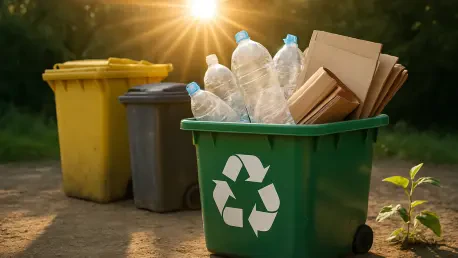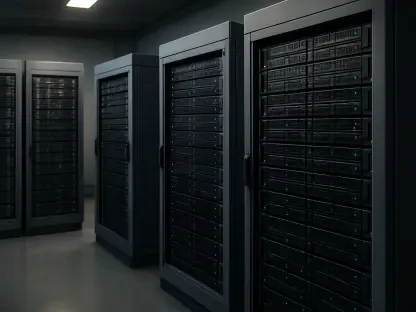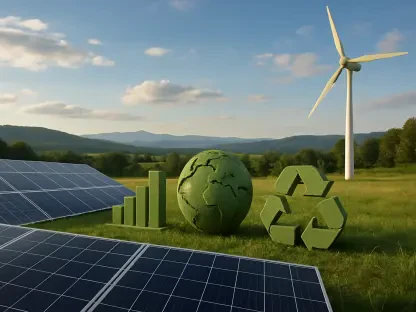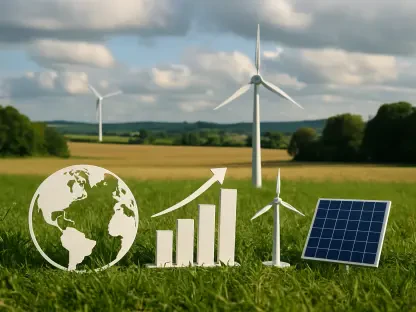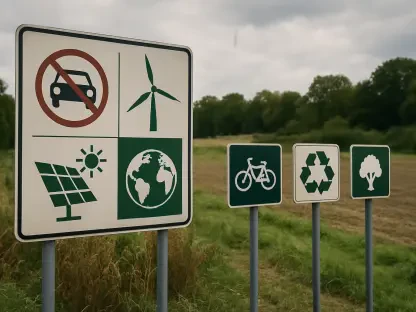Singapore stands as a beacon of efficiency in many realms, but its latest environmental achievement is turning heads for reasons beyond the usual recycling rhetoric, showcasing a unique approach to sustainability. While much of the world fixates on recycling rates as the ultimate measure of environmental progress, this city-state has quietly carved a different path by slashing the sheer volume of waste it produces. In 2024, despite a dip in recycling figures, Singapore’s story of waste reduction reveals a deeper, more impactful shift. This isn’t merely about statistics; it’s about a fundamental change in mindset that could redefine how sustainability is approached globally. The focus on curbing waste at the source offers lessons that extend far beyond its borders, challenging conventional environmental metrics.
What makes this narrative compelling is the contrast between declining recycling rates and the remarkable progress in waste generation. Over the past decade, total waste has dropped from 7.5 million tons to 6.7 million tons, even as population and economic output have climbed. This decoupling of growth from garbage signals a powerful trend. Meanwhile, per capita domestic waste has fallen from 1.08 kg to 850 g per person daily, a reduction equivalent to discarding 14 fewer plastic bottles each day. These numbers paint a picture of progress that recycling rates alone cannot capture, urging a broader perspective on what true environmental success looks like.
The Bigger Picture: Waste Reduction as the True Hero
Upstream Wins Over Downstream Fixes
Singapore’s strategy to address waste before it even materializes aligns with the globally recognized waste hierarchy, which places prevention and reduction above recycling or disposal. This upstream approach challenges the often-misguided notion that high recycling rates can justify rampant overconsumption. Instead, it pushes for a critical examination of production and consumption patterns. By emphasizing prevention through smarter product design, sustainable business practices, and mindful consumer habits, Singapore is tackling the root causes of waste. This method, though more complex and requiring widespread collaboration, delivers environmental benefits that far outweigh the impact of recycling waste after it’s created. The shift in focus from merely managing waste to avoiding it altogether marks a progressive step that other nations might consider emulating.
Another angle to this upstream priority is its influence on long-term sustainability goals. Reducing waste at the source not only lessens the burden on recycling systems but also conserves resources and cuts down on pollution linked to waste processing. For instance, when businesses opt for durable materials or minimize packaging, the ripple effect touches every stage of the supply chain. Similarly, when households adopt habits like refusing single-use items, the cumulative impact is substantial. Singapore’s success in lowering waste generation despite economic growth showcases how upstream interventions can break the link between development and environmental degradation. This approach serves as a reminder that the most effective waste management begins long before anything reaches a bin.
Measuring Success Beyond Recycling Stats
While recycling rates often dominate environmental discussions, they don’t tell the full story of Singapore’s progress. In 2024, the recycling rate fell to 50%, a decade-low compared to 60% ten years prior. At first glance, this decline might seem alarming, but it overshadows a more significant achievement: the consistent drop in waste production. Total waste figures and per capita metrics offer a clearer reflection of behavioral and systemic changes than the fluctuating recycling percentages. This broader lens reveals that sustainability isn’t just about processing waste but about generating less of it in the first place. By focusing on these metrics, Singapore provides a nuanced view of environmental responsibility that prioritizes impact over optics.
Further exploration into this metric shift highlights how waste reduction mirrors local efforts more accurately than recycling rates, which are often swayed by external variables. The reduction in domestic waste to 850 g per person daily, alongside a drop in non-domestic waste relative to GDP, points to tangible changes in consumption and production habits. Businesses have cut waste per billion dollars of GDP from 35 tons daily a decade ago to 24 tons in 2024, reflecting smarter material use. This progress, achieved amidst population and economic growth, underscores a deliberate move toward efficiency. It suggests that true environmental strides lie in transforming how resources are used, rather than relying solely on end-of-pipe solutions like recycling.
Challenges in the Recycling Landscape
External Volatility and Local Limits
Singapore’s recycling rates are heavily influenced by factors beyond its control, a reality tied to its small size and limited capacity for local processing. As a nation that exports much of its recyclable materials, fluctuations in global markets, shipping costs, and foreign import policies directly impact outcomes. For example, policies like China’s 2018 restriction on contaminated recyclables have tightened export options, while rising freight costs can render exporting unprofitable. These external pressures mean that recycling rates often fail to reflect the actual efforts of Singaporean households or businesses. Instead, they highlight a structural challenge: reliance on international systems. This volatility reinforces why waste reduction, a more controllable and locally driven metric, emerges as a steadier focus for sustainable progress.
Delving deeper into this issue, the constraints of being a small nation amplify the unpredictability of recycling outcomes. Without sufficient domestic demand or infrastructure to process all recyclables locally, Singapore must navigate a complex web of global trade dynamics. When market prices for materials like plastic or paper drop, or when destination countries impose stricter regulations, the recycling rate dips regardless of local collection efforts. This disconnect between effort and outcome reveals a critical limitation in using recycling as the primary measure of environmental success. It also underscores the importance of upstream strategies that lessen dependence on such unpredictable systems, ensuring that sustainability efforts remain effective even when external conditions shift.
Contamination and System Gaps
A persistent barrier to effective recycling in Singapore lies in contamination, which severely hampers the usability of collected materials. Approximately 40% of items placed in recycling bins are rendered unusable due to food residue, incorrect materials, or improper disposal practices. Items like greasy pizza boxes or half-empty beverage containers lose their commercial value and often end up in landfills or incinerators instead of being recycled. This high contamination rate signals a gap in public awareness about proper recycling practices and points to the need for systemic improvements. Addressing this issue is crucial to maximizing the potential of recycling efforts for the waste that cannot be avoided through reduction strategies.
Beyond awareness, the design of recycling systems themselves contributes to these challenges. Current bin designs and collection processes often fail to prevent or mitigate contamination, leading to mixed waste streams that are difficult to sort. Trials are underway to refine these systems, with innovations aimed at improving separation at the point of disposal. Additionally, initiatives like the upcoming Beverage Container Return Scheme seek to ensure cleaner, more uniform recyclable inputs by incentivizing proper returns. These efforts highlight a dual need: educating the public on correct disposal habits while reengineering the infrastructure to handle waste more efficiently. Tackling contamination could significantly boost recycling outcomes, complementing the broader push for waste reduction.
Rising Waste Streams Amid Progress
The E-Commerce Packaging Puzzle
Even as Singapore celebrates an overall decline in waste generation, certain categories are bucking the trend, with paper and cardboard waste rising by 3% to a decade-high disposal rate of 400 g per person daily in 2024. This increase is particularly striking given the global move toward digitalization, which might suggest less reliance on paper. However, the surge in e-commerce offers a clear explanation—online shopping has fueled a boom in packaging materials like cardboard boxes and paper fillers. This specific challenge illustrates that broad success in waste reduction doesn’t automatically resolve niche issues. It calls for targeted interventions to address the environmental footprint of modern consumer trends without derailing overall progress.
Looking closer at this issue, the rapid growth of e-commerce has transformed how goods are delivered, often at the cost of increased waste. Each online purchase typically arrives wrapped in layers of protective materials, much of which ends up discarded after a single use. While consumers enjoy the convenience, the environmental toll mounts, particularly in a densely populated hub like Singapore where waste management systems are already under pressure. Solutions might include encouraging businesses to adopt minimal or reusable packaging options and promoting consumer awareness about recycling or reusing these materials. Without tailored strategies, this rising waste stream risks undermining the hard-won gains in other areas, highlighting the need for agility in addressing emerging challenges.
Adapting to Modern Consumption Trends
The rise in paper and cardboard waste underscores a broader tension between technological advancements and environmental goals. As digital platforms drive convenience and efficiency in shopping, they inadvertently contribute to physical waste through packaging demands. This paradox requires innovative thinking to align modern consumption with sustainability. Businesses involved in e-commerce could explore biodegradable materials or standardized reusable packaging systems to curb waste. At the same time, logistics optimizations, such as consolidating deliveries, could reduce the volume of packaging needed. Adapting to these trends is essential to ensure that progress in waste reduction isn’t offset by new, unchecked sources of waste.
Another facet of this adaptation lies in engaging consumers as active participants in managing packaging waste. Public campaigns could emphasize the importance of breaking down boxes for recycling or repurposing materials for household use. Partnerships between e-commerce platforms and waste management authorities might also facilitate take-back programs or drop-off points for packaging returns. These steps, though incremental, could collectively mitigate the impact of rising waste streams. Singapore’s ability to pivot and address such specific challenges will be critical in maintaining its trajectory toward sustainability. By balancing innovation with practical action, the nation can tackle the side effects of modern lifestyles while reinforcing its commitment to a waste-light future.
Strategies for a Waste-Light Future
Business and Household Action
Singapore’s journey toward minimizing waste hinges on collective action across businesses and households, each playing a pivotal role in shaping a sustainable future. For businesses, the push is toward designing products with longevity in mind, favoring durability, reuse, and repair over disposability. Adopting reusable packaging and implementing take-back schemes are practical steps that cut down on waste at the source. Supply chain optimizations, like reducing over-packaging and improving inventory management to avoid surplus, also make a significant dent. These efforts, supported by real-world examples of companies switching to sustainable practices, demonstrate how industry can lead in redefining production norms to align with environmental goals.
Households, meanwhile, are encouraged to embrace small but impactful changes in daily routines. Simple habits such as using reusable bags, refusing single-use plastics, planning meals to prevent food waste, and opting to repair items instead of replacing them contribute to a larger cultural shift. Public campaigns by organizations like the Singapore Environment Council, with initiatives such as “Don’t Waste, Reduce Lah!”, play a key role in reinforcing these behaviors. By framing waste reduction as an accessible, everyday choice, these efforts foster a sense of shared responsibility. Together, the combined actions of businesses and individuals are building a foundation where generating less waste becomes the standard, not the exception, paving the way for lasting change.
Systemic Innovations and Public Engagement
Beyond individual and corporate efforts, systemic innovations are critical to sustaining Singapore’s waste reduction momentum. One pressing area is the redesign of recycling infrastructure to address issues like contamination, which currently renders a large portion of recyclables unusable. Improved bin designs, streamlined collection processes, and initiatives like the Beverage Container Return Scheme aim to enhance the quality of materials collected, making recycling more effective for unavoidable waste. These structural changes, paired with ongoing trials to refine systems, reflect a commitment to tackling logistical barriers head-on. Such innovations ensure that when waste reduction isn’t fully achievable, the fallback systems are as efficient as possible.
Equally important is the role of public engagement in driving systemic change. Education campaigns that clarify recycling guidelines and highlight the importance of waste prevention can significantly alter consumer behavior. By fostering a deeper understanding of how individual actions impact broader environmental goals, these initiatives bridge the gap between policy and practice. Community-driven programs, alongside government and organizational support, create a feedback loop where public input shapes better systems, and improved systems encourage public participation. This synergy is vital for long-term success, ensuring that both the technical and cultural aspects of waste management evolve together to support Singapore’s vision of a sustainable, waste-light future.
